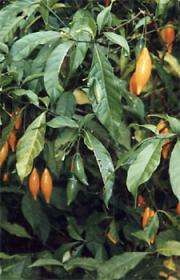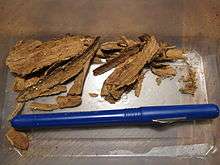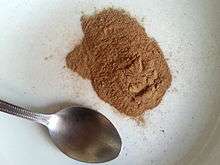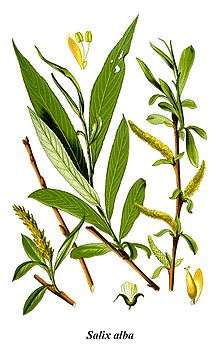Tabernanthe iboga
Tabernanthe iboga (iboga) is a perennial rainforest shrub native to West Africa. An evergreen bush indigenous to Gabon, the Democratic Republic of Congo, and the Republic of Congo, it is cultivated across West Africa.
| Iboga | |
|---|---|
 | |
| Scientific classification | |
| Kingdom: | Plantae |
| Clade: | Tracheophytes |
| Clade: | Angiosperms |
| Clade: | Eudicots |
| Clade: | Asterids |
| Order: | Gentianales |
| Family: | Apocynaceae |
| Genus: | Tabernanthe |
| Species: | T. iboga |
| Binomial name | |
| Tabernanthe iboga | |
In African traditional medicine and rituals, chewing the yellow-colored root or bark is used to produce hallucinations and near-death outcomes, with some fatalities occurring.[3][4] Preliminary research indicates that ibogaine, an alkaloid constituent of iboga roots and bark, has potential for treating addiction to opioids and other substances of abuse.[4] In high doses, ibogaine is considered to be toxic, and has caused serious comorbidities when used with opioids or prescription drugs.[3][5] The United States Drug Enforcement Administration (DEA) lists ibogaine as a controlled substance of the Controlled Substances Act.[3]
Description
Iboga is native to tropical forests, preferring moist soil in partial shade.[3] It bears dark green, narrow leaves and clusters of white tubular flowers on an erect and branching stem, with yellow-orange fruits resembling an olive.[3]
Normally growing to a height of 2 m, T. iboga may eventually grow into a small tree up to 10 m tall, given the right conditions. Its flowers are white and pink, while the fruit can be either an elongated oval shape, or a round spherical shape, both having an orange color. Its yellow-colored roots contain a number of indole alkaloids, most notably ibogaine, which is found in the highest concentration in the root-bark. The root material, bitter in taste, causes anesthetic sensation in the mouth as well as systemic numbness to the skin.
Alkaloids
Indole alkaloids, which make up about 6% of the root chemical composition of iboga,[3] include:
Traditional use

The Iboga tree is central to the Bwiti spiritual practices in West-Central Africa, mainly Gabon, Cameroon and the Republic of the Congo, where the alkaloid-containing roots or bark are used in various ceremonies to create a near-death experience.[3] Iboga is taken in massive doses by initiates of this spiritual practice, and on a more regular basis is eaten in smaller doses in connection with rituals and tribal dances performed at night. Bwitists have been subject to persecution by Catholic missionaries.[3] Léon M'ba, before becoming the first President of Gabon in 1960, defended the Bwiti religion and the use of iboga in French colonial courts. In 2000, the Council of Ministers of the Republic of Gabon declared Tabernanthe iboga to be a national treasure.[6]
In lower doses, iboga has a stimulant effect and is used to maintain alertness while hunting.[7][8]
Addiction treatment claims
Anecdotal reports of self-treated opioid addicts indicated a reduced desire to sustain opiate abuse following iboga ingestion.[3] Since 1970, iboga has been legally prohibited in the United States following several fatalities.[3][4] Preliminary research for the potential use of ibogaine in the treatment of opioid dependence is ongoing in the 21st century, with several clinics using ibogaine in Western countries, Panama, and Caribbean islands.[3] Iboga extracts, as well as the purified alkaloid ibogaine, have attracted attention because of their purported ability to reverse addiction to drugs such as alcohol and opiates.[3] Ibogaine is a k-opioid agonist which may be the mechanism for how it affects opiate withdrawal symptoms.[4]
Ibogaine is classified as a schedule 1 controlled substance in the United States, and is not approved there for addiction treatment (or any other therapeutic use) because of its hallucinogenic and cardiovascular side effects, as well as the absence of safety and efficacy data in human subjects.[3][5] In most other countries, it remains unregulated and unlicensed.[9]
Independent ibogaine treatment clinics have emerged in Mexico, Canada, the Netherlands, South Africa, and New Zealand, all operating in what has been described as a "legal gray area".[9][10] Covert, illegal neighborhood clinics are also known to exist in the United States, despite active DEA surveillance.[8] Addiction specialists warn that the treatment of drug dependence with ibogaine in non-medical settings, without expert supervision and unaccompanied by appropriate psychosocial care, can be dangerous — and, in approximately one case in 300, potentially fatal.[3][10]
Legal status
Iboga is outlawed or restricted in Belgium, Poland, Denmark, Croatia, France,[11] Sweden, and Switzerland. In the United States, ibogaine is classified by the Controlled Substances Act on the list of schedule I drugs[3], although the plant itself remains unscheduled.
Non-profit organization Föreningen för hollistisk missbruksvård is trying to convince the Swedish government to start up clinical investigations of its anti-addictive properties, loosen up the prohibition law against ibogaine, and allow the creation of treatment facilities in Sweden.[12]
Exportation of iboga from Gabon is illegal since the passage of a 1994 cultural protection law.[13]

Conservation status
While little data is available on the exploitation and existing habitat of the iboga plant, the destructive effects of harvesting and slow growth could have already severely damaged the wild iboga population.[14]
Documentary films about iboga
- Iboga, les hommes du bois sacré (2002)
- In this French-language film, Gilbert Kelner documents modern Bwiti practices and Babongo perspectives on iboga.[15] Odisea broadcast a Spanish-dubbed version titled Los hombres de la madera ("The Men of the Wood").[16]
- Ibogaine: Rite of Passage (2004)
- Directed by Ben Deloenen.[17] A 34-year-old heroin addict undergoes ibogaine treatment with Dr Martin Polanco at the Ibogaine Association, a clinic in Rosarito Mexico. Deloenen interviews people formerly addicted to heroin, cocaine, and methamphetamine, who share their perspectives about ibogaine treatment. In Gabon, a Babongo woman receives iboga root for her depressive malaise. Deloenen visually contrasts this Western, clinical use of ibogaine with the Bwiti use of iboga root bark, but emphasizes the Western context.[18]
- "Babongo" (2005)
- In this episode (series 1, episode 4) of the English documentary series Tribe, presenter Bruce Parry ingests iboga during his time with the Babongo. BBC 2 aired the episode on 25 January 2005.[19]
See also
References
- "Tabernanthe iboga Baill". Plants of the World Online. The Trustees of the Royal Botanic Gardens, Kew. n.d. Retrieved July 8, 2020.
- "Tabernanthe iboga Baill". World Flora Online. The World Flora Online Consortium. n.d. Retrieved July 8, 2020.
- "Iboga". Drugs.com. 23 January 2019. Retrieved 28 October 2019.
- Koenig, Xaver; Hilber, Karlheinz (29 January 2015). "The Anti-Addiction Drug Ibogaine and the Heart: A Delicate Relation". Molecules. 20 (2): 2208–2228. doi:10.3390/molecules20022208. ISSN 1420-3049. PMC 4382526. PMID 26807959.
- "Ibogaine". ToxNet, National Library of Medicine, US National Institutes of Health. 4 September 2014. Retrieved 28 October 2019.
- "Iboga Culture, Tradition & Modern Therapeutic Uses | Psychedelic Times". 2020-06-02. Archived from the original on 2020-06-02. Retrieved 2020-06-02.
- McGown, Jay (2006). "Out of Africa: Mysteries of Access and Benefit Sharing" (PDF). Edmonds Institute. Archived from the original (PDF) on December 24, 2012. Retrieved July 28, 2014.
- Hunter, Aina (December 13, 2005). "Busted for Iboga". Village Voice. Retrieved July 28, 2014.
- Hegarty, S. (13 April 2012). Can a hallucinogen from Africa cure addiction? BBC News archive. Retrieved June 17, 2015.
- "Ibogaine therapy for drug addiction". Multidisciplinary Association for Psychedelic Studies. 2019. Retrieved 27 October 2019.
- "Arrêté du 12 mars 2007 modifiant l'arrêté du 22 février 1990 fixant la liste des substances classées comme stupéfiants" [Decree of 12 March 2007 amending the Decree of 22 February 1990 establishing the list of substances classified as narcotics]. admi.net (in French). 2007. Retrieved July 28, 2014.
- "ibogain.se – Föreningen för Holistisk missbruksvård" (in Swedish). Retrieved 2020-06-02.
- "Loi n°2/94 du 23 décembre 1994 portant sur la protection des biens culturels" [Law No. 2/94 of 23 December 1994 on the protection of cultural property]. African Archaeology (in French). 2008. Retrieved July 28, 2014.
- Tonye, Mahop Marcelin; et al. (March 2000). "State of Knowledge Study on Tabernanthe Iboga Baillon: A Report For The Central African Regional Program For The Environment" (PDF). Limbe Botanic Garden. Retrieved July 28, 2014.
- L' Iboga, Les Hommes du Bois Sacré, retrieved 2020-06-02
- "Iboga, los Hombres de la Madera Sagrada [Documental]". Vimeo. Retrieved 2020-06-02.
- Ibogaine: Rite of Passage (2004) on IMDb
- IBOGAINE - Rite of Passage (Full Documentary), retrieved 2020-06-02
- Tribe series 1, episode 4: "Babongo" (2005) on IMDb
External links
| Wikimedia Commons has media related to Tabernanthe iboga. |
- Holy War- A Tale of Bwiti Initiation, Part 1 by Jim Dziura (Psychedelic Times, 2018)
- Holy War- A Tale of Bwiti Initiation, Part 2 by Jim Dziura (Psychedelic Times, 2018)
- Plants of The Gods by Richard Evans Schultes and Albert Hofmann (Healing Arts Press, 1992)
- Adam, Eve and Iboga, Giorgio Samorini. (Originally published in Integration 4: 4-10)
- The Bwiti Religion and the psychoactive plant Tabernanthe iboga (Equatorial Africa), Giorgio Samorini. (Originally published in Integration 5: 105-114)
- Pharmacodynamics and Therapeutic Applications of Iboga and Ibogaine, Robert Goutarel, Otto Gollnholfer and Roger Sillans (Originally published in Psychedelic Monographs and Essays, 6:70-111 (1993).
- The Religion of Iboga or Bwiti of the Fang, P. Barabe. (originally published as "La religion d'Eboga ou le Bwiti des Fanges", Med. trop. 12(3):251-257, (May/June) 1982)
- Tabernanthe iboga in West African plants – A Photo Guide.
- African Spirit Medicine Patrick Haize writes in Vision Magazine about his experience getting treated at Crossroads Ibogaine Treatment Center in Rosarito, Mexico.
- Trips Beyond Addiction | Living Hero Radio Show and Podcast special. With Dimitri Mobengo Mugianis, Bovenga Na Muduma, Clare S. Wilkins, Brad Burge, Tom Kingsley Brown, Susan Thesenga, Bruce K. Alexander, PhD ~ the voices of ex-addicts, researchers from The Multidisciplinary Association for Psychedelic Studies and Ibogaine/Iboga/Ayahuasca treatment providers sharing their experiences in breaking addiction with native medicines. Jan 2013. (Soundcloud archive of the full 1:27:09 episode)
